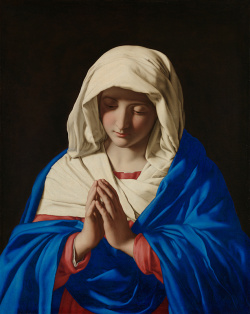 What happened to Mary? This is a question that could easily occur to anyone reading through 20th-century theology. Marian theology up to the 1960s was vibrant and flourishing. Fr. Edward O’Connor’s 1958 magisterial volume The Immaculate Conception (recently re-released by University of Notre Dame Press) seems to sum up an era. The lively essays harvest the best of traditional theology and seem poised to surge ahead, bursting as they are with both creativity and fidelity. And yet, ten years after its publication, Marian study was nearly dead. This book remains unsurpassed in its field.
What happened to Mary? This is a question that could easily occur to anyone reading through 20th-century theology. Marian theology up to the 1960s was vibrant and flourishing. Fr. Edward O’Connor’s 1958 magisterial volume The Immaculate Conception (recently re-released by University of Notre Dame Press) seems to sum up an era. The lively essays harvest the best of traditional theology and seem poised to surge ahead, bursting as they are with both creativity and fidelity. And yet, ten years after its publication, Marian study was nearly dead. This book remains unsurpassed in its field.
What happened to Mary? This same question could be asked by anyone old enough to remember Marian piety before 1968, even if, as is more and more likely now, they were only children at the time of Vatican II, which closed that year. Marian piety had seemed so alive and well that it seemed unthinkable that it could be dislodged. But within ten years of the Council, it had all but vanished.
What happened to Mary? This same question is most likely not to be asked by Church members who grew up in the post-conciliar Church. The tragedy of any enduring loss is that eventually no one notices anything is missing. When one’s spiritual sensibilities have been dulled through lack of use, one lives an impoverished spiritual life without even realizing it. The question is not likely to occur to those born in the 70s or later, unless, perhaps, they travel to regions in the world or encounter subcultures within our own society where Marian devotion is alive and well. The encounter can almost seem shocking to the person whose spiritual sensibilities are thereby newly awakened. They might very well be prompted to ask, “But what happened to our Mary?”
The Loss of Marian Devotion
Well, what did happen to Mary? It can seem correct to jump to the conclusion, “Vatican II, that’s what!” After all, it’s the most obvious marker for the dramatic decline both in Marian theology and Marian devotion since 1968. And yet, the Council itself actually called for a renewal of Marian devotion. In fact, by bookending the Dogmatic Constitution on the Church, Lumen Gentium (LG), with an opening chapter on the mystery of the Church and a closing chapter on Mary, Mother of God, the Council tied contemplation of the mystery of the Church to a contemplation of the mystery of Mary. The Council thereby linked renewal of the Church as mystery to a renewal of a sense of the mystery of Mary.
How did the Fathers of the Council do this? By linking both to the mystery of the Incarnation. The opening lines of the Mary chapter invoke Galatians 4:4, specifically, “when the fullness of time came, God sent His Son, born of a woman . . . that we might receive the adoption of sons” (LG 52).[i] The next sentence quotes the Creed: “He for us men, and for our salvation, came down from heaven, and was incarnate by the Holy Spirit from the Virgin Mary” (LG 52). In the same section, we also read: “This divine mystery of salvation is revealed to us and continued in the Church, which the Lord established as His Body” (LG 52). This links Mary, through the Incarnation, to the Church.
This latter passage recalls an earlier passage from chapter one, the other bookend, on the mystery of the Church. It discusses the mystery of the Church as a visible society on earth, in one way like any other visible society on earth and yet in another way totally unlike any other such society, possessed of divine life as the mystical body of Christ. “The society equipped with hierarchical organs and the Mystical body of Christ, are not to be considered as two realities, nor are the visible assembly and the spiritual community, nor the earthly Church and the Church enriched with heavenly things; rather they form one complex reality which coalesces from a divine and a human element.” Most significantly then, the constitution continues, “For this reason, by no weak analogy, [the Church] is compared to the mystery of the incarnate Word” (LG 8).
The Church, no less than the mystery of the continuation of the Incarnation as the Mystical body, has, as such, a mother—namely, Mary. Indeed, “She is ‘the mother of the members of Christ . . . having cooperated by charity that the faithful might be born in the Church, who are members of that Head’” (LG 53).[ii] Her loving fiat to the angel Gabriel brought about the birth of Christ—including the whole of that Body of which he is so glorious a Head. We do not truly encounter Christ or the Church as mystery unless we encounter Mary.
And so the Council strongly exhorts us to Marian devotion: “Joined to Christ the Head and in the unity of fellowship with all His saints, the faithful must in the first place reverence the memory ‘of the glorious ever Virgin Mary, Mother of our God and Lord Jesus Christ’” (LG 52).[iii] And, “The Catholic Church, taught by the Holy Spirit, honors her with filial affection and piety as a most beloved Mother” (LG 53).[iv] This has been true “from earliest times” (LG 66). The Council exhorts us to remember that “true devotion . . . proceeds from true faith, by which we are led to know the excellence of the Mother of God, and we are moved to a filial love toward our mother” (LG 67).[v]
Why? To repeat: Without devotion to Mary, we do not truly encounter either the Incarnation or the Church, which is the continuation of the Incarnation and not just a human association like the National Railroad Passenger Corporation, aka Amtrak. Contemplating the mystery of Mary in the faith that she is Mother of God means being moved toward a filial love of her because we become more and more aware of the mystery of ourselves precisely as members of the Church, members of the Body of her Son. Amtrack doesn’t have a mother. But as members of the Church, we do. St. Augustine reminds us that, as members of the Church, “we are not only Christians, but Christ himself” (see CCC 795). Head and Body are the “whole Christ,” and the whole Christ has a mother. Her name is Mary.
What Happened to the Church?
Besides asking what happened to Mary, we could equally go on to ask, what happened to the Church? Since 1968, in the same regions where Mary has all but dropped out of Catholic life, the Church herself has wasted away, to the point where some claim the Church is dead in these places. What happened? The answer is obviously complex, and terrible scandals and deep-seated dissent from Church teaching since 1968 have certainly had their grim effect.
But, from another point of view, could the answer be as simple as, “We lost Mary”? Pope St. Paul VI said that “The Church’s devotion to the Blessed Virgin is intrinsic to Christian worship” (see CCC 971). Not “icing on the cake,” not “optional,” and not only “in emergencies.” “Intrinsic.” This means that something essential to Church life is lost if devotion to Mary is lost, and Church life is atrophied to an equal extent.
Why? Because the loss of Mary means the loss of a concrete sense of the Church as a divine mystery, a mystery not reducible to human reason and a society that is not a work of our own making. The loss of filial devotion to Mary means the loss of a sense of the mystery of one’s own person as a member of Christ, as Christ. Contrariwise, devotion to Mary resists a rationalized, one-dimensional account of the Church as though it were merely one club or society or corporation like any other, like Amtrak, essentially our creation, ordered on the analogy of any secular organization and left when it no longer meets our preferences, be they modernist or traditionalist.
This one-dimensional view, I would propose, is the unarticulated view of most American Catholics, especially younger Catholics and their parents. Otherwise, it wouldn’t seem so easy just to pick another such “club,” one whose teachings on marriage or ordination or the sanctity of life seem more reflective of contemporary cultural preferences. It wouldn’t seem so easy to opt out altogether from “organized religion” to join the ranks of the “spiritual but not religious.” These options assume a flat, rationalized, secularized view of the Church without realizing it. But the filial devotion that the Council recommends means invoking Mary as mother, indeed as our own mother, insofar as we are, as members of the Church, Christ himself, her adorable Son. Devotion to Mary means contemplating more and more concretely the adorable, worship-worthy love of the divine person who bent down and took us to himself as himself, including our most embarrassing and vulnerable moments, such that even those moments of desperation, abandonment, loneliness, and failure, when they are touched by him now also share in his life.
So, what happened to Mary? What happened to the Church? Mary was forgotten and, at the same time, the Church was quietly, even unconsciously, rationalized into a human society shorn of any depth of mystery. What you see is what you get. Why bother with the Church, scandal ridden as it is and out of step with contemporary attitudes toward sexuality and life itself? This doesn’t mean not trying to correct scandals. My point is, rather, that we won’t be able to answer this last question unless we also become more deeply aware of the first: “What happened to Mary?” If we do not feel the loss of Marian devotion more and more deeply and correct course, our efforts at evangelization will continue to be weakened, hamstrung by the lack of an intrinsic appeal supplied only by Mary. Renewing evangelization in an age of disaffiliation means recovering this intrinsic element of Christian worship we have mostly even forgotten to miss. This was the vision of the Second Vatican Council. It cannot be, since all this is true, that it is too late to recover it.
Dr. John C. Cavadini is Professor of Theology at the University of Notre Dame and the McGrath-Cavadini Director of the McGrath Institute for Church Life.
Notes
[i] Quoting Gal 4:4.
[ii] Quoting St. Augustine, On Holy Virginity 6.
[iii] Quoting the Roman Canon (emphasis added).
[iv] Emphasis added.
[v] Emphasis added.
This article originally appeared on pages 7-9 of the printed edition.
Art Credit: The Virgin in Prayer by Sassoferrato, courtesy of The National Gallery, UK; Lourdes 2023 Procession, Diocese of Nottingham, Flickr.com CC
This article is from The Catechetical Review (Online Edition ISSN 2379-6324) and may be copied for catechetical purposes only. It may not be reprinted in another published work without the permission of The Catechetical Review by contacting [email protected]


















